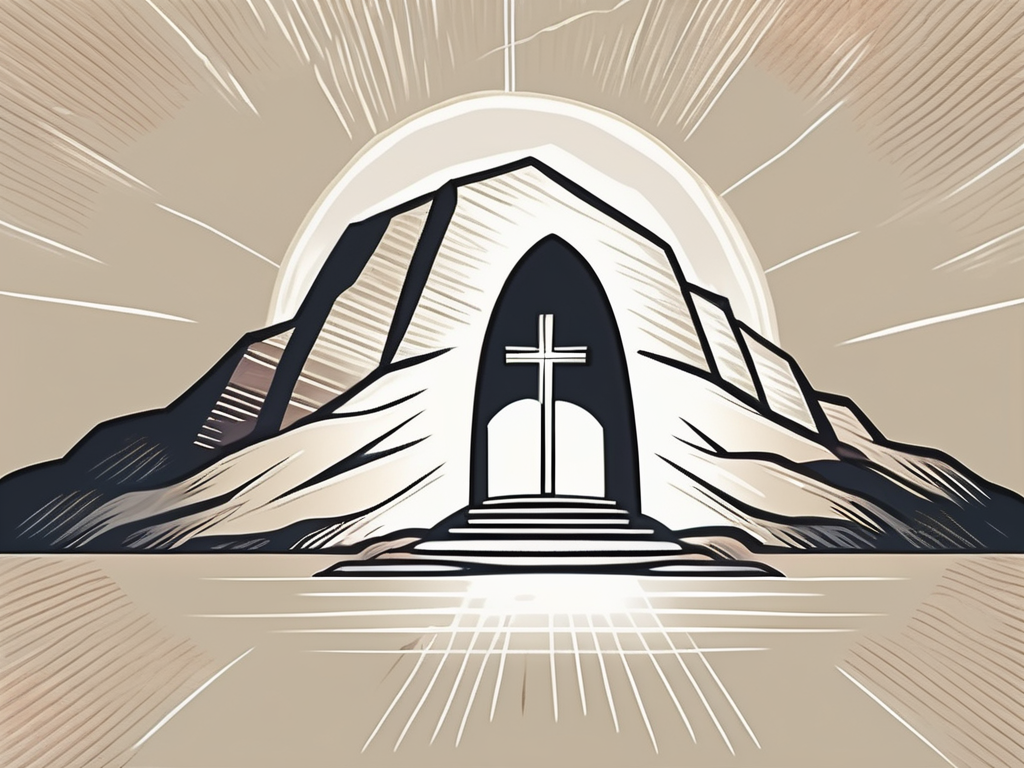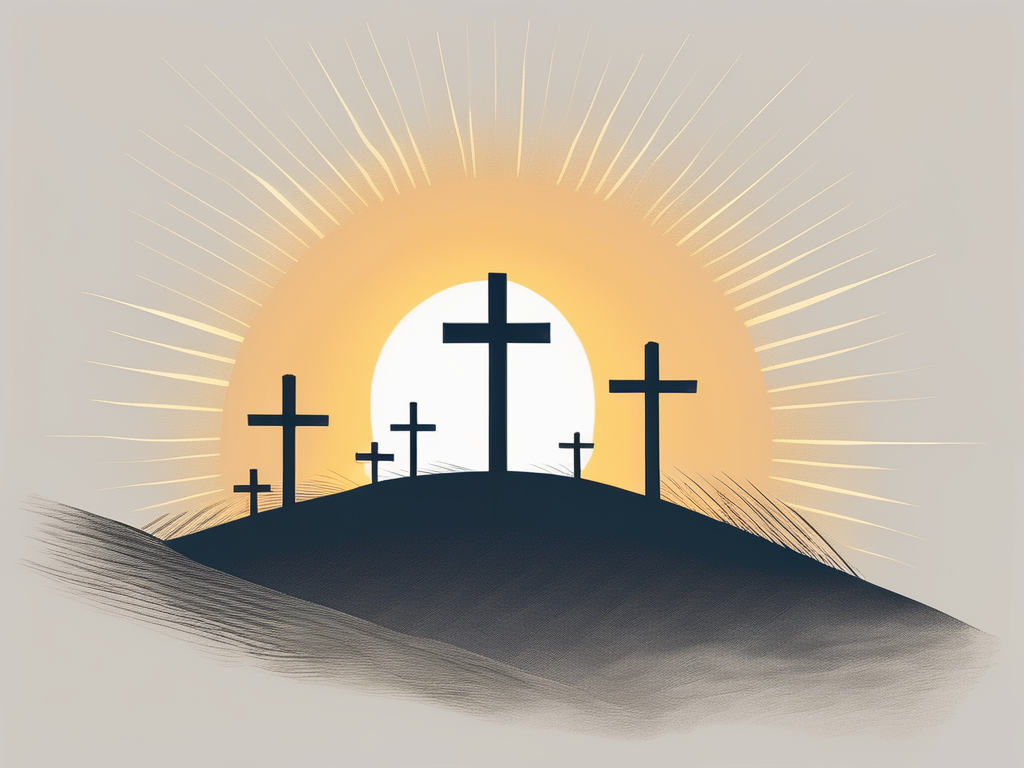Christianity, one of the world’s largest religions, has a rich and complex history that stretches back centuries. In order to understand this faith, we must delve into its origins and trace its religious roots.
Understanding the Birth of Christianity
At the heart of Christianity is the figure of Jesus Christ. Born in Bethlehem, Jesus played a pivotal role in the formation of this religion. His teachings, miracles, and ultimately his crucifixion and resurrection, laid the foundation for the belief system that would become Christianity.
However, it is essential to note that early Christianity did not emerge in a vacuum. Its birth was deeply entwined with its parent religion, Judaism.
The Role of Jesus Christ in the Formation of Christianity
Jesus’ teachings challenged the religious norms of his time. He preached love, forgiveness, and a personal relationship with God. These radical ideas resonated with many, and as his followers grew, so did the distinctiveness of this new faith.
Jesus’ message of love and forgiveness was revolutionary in a society that was governed by strict religious laws and rituals. His emphasis on compassion and mercy attracted people from all walks of life, including the marginalized and oppressed.
Furthermore, Jesus’ miracles, such as healing the sick and raising the dead, demonstrated his divine power and authority. These extraordinary acts not only solidified his followers’ belief in his teachings but also attracted attention from both admirers and skeptics.
However, Jesus’ crucifixion and subsequent resurrection were the defining moments in the formation of Christianity. His sacrificial death was seen as the ultimate act of love and redemption, offering salvation to all who believed in him.
Moreover, Jesus’ resurrection from the dead was seen as a triumph over death and a confirmation of his divine nature. This event solidified the belief in his teachings and gave hope to his followers that they too could experience eternal life.
The Influence of Judaism on Early Christianity
Despite the differences that would eventually emerge between Judaism and Christianity, it is important to acknowledge the significant influence that Judaism had on the early Christian community. Jesus himself was Jewish, as were many of his first disciples and followers.
Jewish traditions, Scriptures, and moral teachings provided the framework upon which Christianity built its theological foundations. The Old Testament, which is shared by both Judaism and Christianity, contains prophecies and foreshadowing of the coming Messiah, which Jesus fulfilled according to Christian belief.
Furthermore, the moral teachings of Judaism, such as the Ten Commandments, formed the basis for Christian ethics and morality. Concepts such as loving one’s neighbor, seeking justice, and caring for the poor and marginalized were deeply ingrained in both religious traditions.
The early Christian community also drew inspiration from Jewish practices and rituals. For example, the early Christians continued to observe the Sabbath and celebrated Jewish festivals, while also incorporating new elements that were specific to their faith.
Overall, the influence of Judaism on early Christianity cannot be overstated. It provided the historical and cultural context within which Christianity emerged, shaping its beliefs, practices, and identity.
The Spread of Christianity in the Roman Empire
The early Christian community faced a tumultuous journey as it navigated the vast and diverse Roman Empire. This period marked both persecution and growth for this burgeoning faith.
As Christianity emerged in the Roman Empire, its followers faced a daunting challenge. The dominant religion at the time, polytheistic paganism, viewed the monotheistic beliefs of Christians as a threat to the established order. Consequently, embracing Christianity was a risky business. Early Christians faced brutal persecution, often being sentenced to death for their refusal to renounce their faith.
Despite the hardships and the constant threat to their lives, Christianity experienced remarkable growth. The unwavering dedication of its followers, coupled with the message of hope and salvation it offered, captivated the hearts and souls of people from all walks of life.
Persecution and Growth: Christianity in the Roman Era
The persecution of Christians in the Roman Empire took various forms. They were subjected to public ridicule, physical torture, and even used as scapegoats for societal problems. The Roman authorities saw them as a threat to the stability of the empire, as their refusal to worship the Roman gods was seen as an act of defiance against the state.
However, even in the face of such adversity, the Christian community continued to grow. The stories of martyrs who willingly sacrificed their lives for their faith inspired others to join their ranks. The underground nature of their gatherings, held in secret catacombs and private homes, only added to the allure and mystique surrounding this new religious movement.
The Conversion of Constantine and the Edict of Milan
A significant turning point in the history of Christianity occurred with the conversion of Emperor Constantine to this fledgling faith. Constantine, who had experienced a vision of a Christian symbol before a decisive battle, attributed his victory to the Christian God. This personal experience led him to embrace Christianity and become its staunch supporter.
With Constantine’s conversion came the Edict of Milan, a decree that legalized and protected the practice of Christianity. This landmark legislation not only put an end to the persecution of Christians but also allowed them to openly worship and spread their faith throughout the empire.
Constantine’s support catapulted Christianity from the fringes of society to a position of power and influence. The construction of grand basilicas and churches, such as the famous St. Peter’s Basilica in Rome, became a testament to the newfound status of Christianity. It was through his patronage that Christianity began its journey as the dominant religion of the Roman Empire.
As Christianity gained more followers and influence, it also underwent significant transformations. The early Christian community, once a persecuted minority, now had to grapple with internal divisions and theological debates. These debates would shape the future of Christianity and lead to the emergence of different branches and denominations.
In conclusion, the spread of Christianity in the Roman Empire was a complex and multifaceted process. It involved both persecution and growth, with the unwavering dedication of its followers and the support of influential figures like Constantine playing crucial roles. The story of Christianity in the Roman Empire is a testament to the resilience and enduring power of faith in the face of adversity.
Key Theological Developments in Early Christianity
As Christianity grew, so did its theological complexities. Theologians and religious leaders grappled with critical questions and attempted to develop cohesive doctrines that would shape the future of the faith.
One of the most significant theological developments in early Christianity was the Council of Nicaea and the formulation of the Nicene Creed. In response to theological disputes, the Council of Nicaea was convened in 325 AD. This gathering brought together bishops from across the empire to address the central issue of Jesus’ divinity.
The debates at the Council of Nicaea were intense and passionate, as different factions presented their arguments and defended their positions. The discussions delved into the nature of Jesus’ relationship with God the Father and the implications of his divinity for salvation. After much deliberation, the council reached a consensus and formulated the Nicene Creed.
The resulting Nicene Creed affirmed the belief in Jesus as the Son of God, of one substance with the Father. This declaration marked a crucial moment in the history of Christianity, solidifying its core beliefs and setting a standard for orthodoxy. The Nicene Creed became a foundational statement of faith, embraced by Christians around the world.
Another significant theological development was the conceptualization of the Trinity – the belief in God as a triune being; Father, Son, and Holy Spirit. This complex doctrine sought to reconcile the monotheistic roots of Judaism with the divinity of Jesus and the presence of the Holy Spirit.
The early theologians grappled with the challenge of articulating the relationship between the three persons of the Trinity. They explored various metaphors and analogies to help explain this divine mystery, such as the image of the three-in-one nature of water (liquid, ice, and vapor) or the three dimensions of time (past, present, and future).
While the full understanding of the Trinity remains a mystery, this concept became a cornerstone of Christian dogma, shaping the beliefs and practices of countless followers. The Trinity was not merely an abstract theological concept; it had practical implications for Christian worship, prayer, and understanding of salvation.
Early Christians grappled with these theological developments, engaging in intellectual debates and seeking to deepen their understanding of the faith. The theological complexities of early Christianity were not merely academic exercises; they had profound implications for the lived experiences of believers.
As the early Christian community grew and spread, theological developments continued to shape the faith. These developments laid the foundation for centuries of theological exploration and debate, as Christians sought to understand and articulate their beliefs in the ever-changing world.
The Split between Eastern and Western Christianity
Over time, theological, cultural, and political differences caused a rift within the Christian world. This divide led to the separation of Eastern and Western Christianity, forever altering the course of the faith.
The split between Eastern and Western Christianity is a complex and multifaceted event that unfolded over centuries. It was not a sudden rupture, but rather a gradual process fueled by a variety of factors. Theological disagreements played a significant role in the growing divide, as scholars and religious leaders grappled with different interpretations of scripture and the nature of God.
Cultural differences also contributed to the split. The Eastern and Western regions of the Christian world had distinct traditions, customs, and languages. These cultural disparities, coupled with political tensions and power struggles, further deepened the divide between the two branches.
The Great Schism: Causes and Consequences
The Great Schism of 1054 marked the formal split between the Eastern Orthodox Church and the Roman Catholic Church. The causes behind this division were numerous, including tensions over authority, liturgical practices, and theological disagreements.
The question of authority was a central issue in the Great Schism. The Roman Catholic Church believed in the supremacy of the Pope, regarding him as the ultimate authority in matters of faith and doctrine. On the other hand, the Eastern Orthodox Church emphasized a more decentralized structure, with authority shared among bishops and patriarchs.
Liturgical practices also played a role in the division. The Eastern Orthodox Church had a rich tradition of mysticism and the use of icons in worship, while the Roman Catholic Church placed greater emphasis on sacraments and rituals.
This schism had profound consequences, resulting in the establishment of two separate branches of Christianity, each with its own distinct traditions, beliefs, and leadership. The Eastern Orthodox Church and the Roman Catholic Church would develop independently, with their own hierarchies, liturgical practices, and theological emphases.
Differences in Doctrine and Practice between Eastern and Western Christianity
The split between Eastern and Western Christianity led to noticeable differences in doctrine and practice. The Eastern Orthodox Church emphasized mysticism, icons, and a decentralized structure, while the Western Church highlighted the authority of the Pope, sacraments, and canon law.
These differences in doctrine and practice had far-reaching implications. The Eastern Orthodox Church’s emphasis on mysticism and the use of icons fostered a deep sense of spirituality and a connection to the divine. The Western Church, on the other hand, placed a strong emphasis on the authority of the Pope, which served as a unifying force for the Roman Catholic faithful.
This divergence would influence the development of these two branches, shaping their identities and laying the groundwork for the diverse expressions of Christianity found today. The Eastern Orthodox Church would go on to have a significant impact on the cultures and societies of Eastern Europe, while the Roman Catholic Church would become a powerful institution in Western Europe and beyond.
Despite the split, there have been ongoing efforts towards reconciliation between the Eastern Orthodox Church and the Roman Catholic Church. Dialogue and ecumenical initiatives seek to bridge the theological and cultural gaps that have divided these two branches for centuries.
The Role of Christianity in the Middle Ages
The Middle Ages, often described as a tumultuous period, witnessed the significant role played by Christianity in shaping society, culture, and even politics.
The Crusades and their Impact on Christianity
The Crusades, a series of military campaigns sanctioned by the Catholic Church, aimed to regain control of Christian holy sites in the Holy Land. These missions had a lasting impact, both on Christians and on the relationship between different religious groups.
While the Crusades were not without controversy and tragedy, they profoundly influenced the religious fervor, medieval worldview, and even the concept of chivalry.
The Church’s Influence on Medieval Society and Culture
Throughout the Middle Ages, the Church became a dominant force, exerting its influence over all aspects of society. It played a central role in education, art, architecture, and morality.
Monastic orders preserved knowledge, charitable institutions cared for the poor and sick, and cathedrals rose as monumental expressions of faith. Christianity helped shape the values, norms, and cultural achievements of medieval Europe.
In conclusion, the origins of Christianity are deeply rooted in the life and teachings of Jesus Christ, influenced by Judaism, and shaped by historical events, theological developments, and cultural factors. As Christianity continued to evolve, it faced challenges, experienced growth, and underwent significant divisions. The role of Christianity in the Middle Ages further solidified its impact on society and culture. Today, Christianity continues to thrive, offering spiritual guidance and a sense of meaning to millions of believers around the world.












